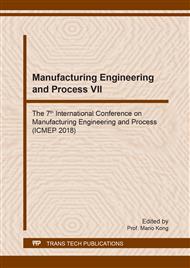[1]
C. Iliescu, J. Jing, F. E. Tay, J. Miao and T. Sun: Characterization of Masking Layers for Deep Wet Etching of Glass in an Improved HF/HCI Solution, Surface & Coatings Technology, Vol. 198, pp.314-318, (2005).
DOI: 10.1016/j.surfcoat.2004.10.094
Google Scholar
[2]
W. Cong, Z. Pei, X. Sun and C. Zhang:Rotary Ultrsonic Machining of CFRP: a Mechanistic Predictive Model for Cutting Force," Ultrasonics, vol. 54, no. 2, pp.663-75, (2014).
DOI: 10.1016/j.ultras.2013.09.005
Google Scholar
[3]
C. Zhang, W. Cong, P. Feng and Z. Pei, : Rotray Ultrasonic Machining of Optical K9 Glass Using Compressed Air as Coolant: a Feasibility Study," J Engineering Manufacturing, vol. 228, no. 4, pp.504-514, (2014).
DOI: 10.1177/0954405413506195
Google Scholar
[4]
K. Ding, F. Yucan, H. Su, Y. Chen, X. Yu and G. Ding: Experimental Studies on Drilling Tool Load and Machining Quality of C/SiC Composites in Rotary Ultrasonic Machining," Journal of Materials Processing Technology , vol. 214, no. 12, pp.2900-2907, (2014).
DOI: 10.1016/j.jmatprotec.2014.06.015
Google Scholar
[5]
Y. El-Taybany, M. Hossam and H. El-Hofy: Experimantal Investigation of Ultrasonic-Assisted Milling of Soda Glass Using Factorial Design of Experiments," Procedia CIRP, vol. 58, pp.381-386, (2017).
DOI: 10.1016/j.procir.2017.03.238
Google Scholar
[6]
S. Amini, M. Soleimani, H. Paktinat and M. Lotfi: Effect of Logitudinal-Torsional Vibration in Ultrasonic Assisted Drilling," Material and Manuf. Process, vol. 32, no. 6, pp.616-622, (2017).
DOI: 10.1080/10426914.2016.1198027
Google Scholar
[7]
Y. Ahmed, W. L. Cong, M. R. Stanco, Z. G. Xu, Z. J. Pei, C. Treadwell, Y. L. Zhu and Z. C. li: Rotary Ultraosnic Machining of Alumina Dental Ceramics: A Preliminary Experimental Study on Surface and Subsurface Damages, Journal of Manufacturing Science and Engineering, vol. 134, pp.064501-5, (2012).
DOI: 10.1115/1.4007711
Google Scholar
[8]
B. Azarhoushang and J. Akbari: Ultrasonic-Assisted Arilling of Inconel 738-LC, International Journal of Machine Tools & Manufacturing, vol. 47, pp.1027-1033, (2007).
DOI: 10.1016/j.ijmachtools.2006.10.007
Google Scholar
[9]
Y. Jiao, P. Hu and Z. J. Pei: Rotary Ultrasonic Machining of Ceramics: Design of Experiments, International Journal Manufacturing Technology and Management, vol. 7, pp.192-205, (2005).
DOI: 10.1504/ijmtm.2005.006830
Google Scholar
[10]
D. Lv, Y. Zhang and Y. Peng: High-Frequancy Vibration Effect on Hole Entrance Chipping in Rotary Ultrasonic Drilling of BK7 glass, Ultrasonics, vol. 72, pp.47-56, (2016).
DOI: 10.1016/j.ultras.2016.07.011
Google Scholar
[11]
J. Wang, H. Zha, P. Feng and J. Zhang: On the Mechanism of Edge Chipping Reduction in Rotary Ultrasonic Drilling: A Novel Experimental Method," Precision Eng., vol. 44, pp.231-235, (2015).
DOI: 10.1016/j.precisioneng.2015.12.008
Google Scholar
[12]
G. Singh, V. Jain, D. Gupta and A. Ghai: Optimization of Process Parameters for Drilled Jole Quality Characteristics During Cortical Bone Drilling using Taguchi Method," Journal of the mechanical behavior of biomedical materials, vol. 63, pp.355-365, (2016).
DOI: 10.1016/j.jmbbm.2016.05.015
Google Scholar


